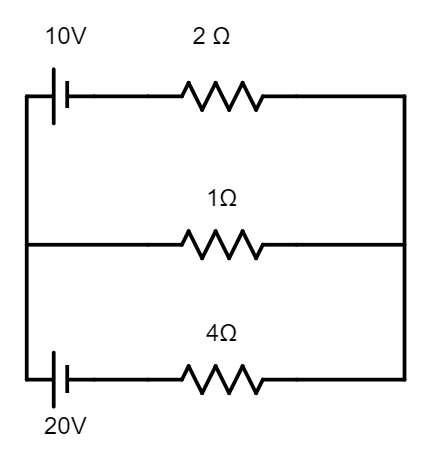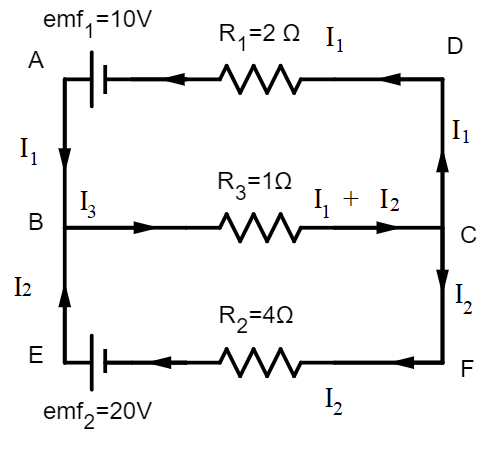
The value of current through $2\Omega $ resistor in the circuit is

A) $10A$
B) $2.1A$
C) $20A$
D) $25A$

Answer
577.5k+ views
Hint: To proceed, we have to apply Kirchhoff’s rules. Kirchhoff’s first rule says that the algebraic sum of the currents meeting at a junction in a closed electric circuit is zero. Kirchhoff’s second rule says that the algebraic sum of change in potential around any closed path of an electric circuit (or closed loop) involving resistors and cells in the loop is zero.
Complete answer:
Firstly, let us redraw the circuit by naming the components according to our comfortability.
Let us name the resistors as
${{R}_{_{1}}}=2\Omega $, ${{R}_{2}}=4\Omega $, and ${{R}_{3}}=1\Omega $
Let the currents flowing through resistors ${{R}_{1}},{{R}_{2}},$ and ${{R}_{3}}$ be ${{I}_{1}},{{I}_{2}},$ and ${{I}_{3}}$, respectively.
We are also provided with two electromotive forces. Let us call them $em{{f}_{1}}=10V$ and $em{{f}_{2}}=20V$, respectively.
Kirchhoff’s first rule or current rule (KCL) says that the algebraic sum of the currents meeting at a junction in a closed electric circuit is zero. It says that
$\sum I=0$

Applying this rule in our circuit, we have
${{I}_{3}}={{I}_{1}}+{{I}_{2}}$, at node B as well as node C. Let this be equation 1.
Kirchhoff’s second rule or voltage rule (KVL) says that the algebraic sum of change in potential around any closed path of an electric circuit (or closed loop) involving resistors and cells in the loop is zero. It says that $\sum emf+\sum IR=0$
Applying this rule in closed loop ABCDA, we have
$-em{{f}_{1}}+{{I}_{3}}{{R}_{3}}+{{I}_{1}}{{R}_{1}}=0\Rightarrow -10+({{I}_{1}}+{{I}_{2}})1+{{I}_{1}}(2)=0\Rightarrow ({{I}_{1}}+{{I}_{2}})+2{{I}_{1}}=10\Rightarrow 3{{I}_{1}}+{{I}_{2}}=10$...Let this be equation 2.
Applying the same rule to the loop EBCFE, we have
$-em{{f}_{2}}+{{I}_{3}}{{R}_{3}}+{{I}_{2}}{{R}_{2}}=0\Rightarrow -20+({{I}_{1}}+{{I}_{2}})1+{{I}_{2}}(4)=0\Rightarrow ({{I}_{1}}+{{I}_{2}})+4{{I}_{2}}=20\Rightarrow {{I}_{1}}+5{{I}_{2}}=20$.....Let this be equation 3.
Solving equation 2 and equation 3, we have
${{I}_{2}}=\dfrac{25}{7}A$ and ${{I}_{1}}=\dfrac{15}{7}=2.1A$
Therefore, the current flowing through the resistor,${{R}_{1}}=2\Omega $ is given by ${{I}_{1}}=2.1A$.
So, the correct answer is “Option B”.
Note:
Kirchhoff’s rules follow sign convention. To make it easy, in KCL, the current flowing towards a node is taken as positive and the current flowing away from the node is taken as negative. In KVL, while traversing a loop, if a negative pole of the cell is encountered first, then its emf is negative, otherwise positive.
Complete answer:
Firstly, let us redraw the circuit by naming the components according to our comfortability.
Let us name the resistors as
${{R}_{_{1}}}=2\Omega $, ${{R}_{2}}=4\Omega $, and ${{R}_{3}}=1\Omega $
Let the currents flowing through resistors ${{R}_{1}},{{R}_{2}},$ and ${{R}_{3}}$ be ${{I}_{1}},{{I}_{2}},$ and ${{I}_{3}}$, respectively.
We are also provided with two electromotive forces. Let us call them $em{{f}_{1}}=10V$ and $em{{f}_{2}}=20V$, respectively.
Kirchhoff’s first rule or current rule (KCL) says that the algebraic sum of the currents meeting at a junction in a closed electric circuit is zero. It says that
$\sum I=0$

Applying this rule in our circuit, we have
${{I}_{3}}={{I}_{1}}+{{I}_{2}}$, at node B as well as node C. Let this be equation 1.
Kirchhoff’s second rule or voltage rule (KVL) says that the algebraic sum of change in potential around any closed path of an electric circuit (or closed loop) involving resistors and cells in the loop is zero. It says that $\sum emf+\sum IR=0$
Applying this rule in closed loop ABCDA, we have
$-em{{f}_{1}}+{{I}_{3}}{{R}_{3}}+{{I}_{1}}{{R}_{1}}=0\Rightarrow -10+({{I}_{1}}+{{I}_{2}})1+{{I}_{1}}(2)=0\Rightarrow ({{I}_{1}}+{{I}_{2}})+2{{I}_{1}}=10\Rightarrow 3{{I}_{1}}+{{I}_{2}}=10$...Let this be equation 2.
Applying the same rule to the loop EBCFE, we have
$-em{{f}_{2}}+{{I}_{3}}{{R}_{3}}+{{I}_{2}}{{R}_{2}}=0\Rightarrow -20+({{I}_{1}}+{{I}_{2}})1+{{I}_{2}}(4)=0\Rightarrow ({{I}_{1}}+{{I}_{2}})+4{{I}_{2}}=20\Rightarrow {{I}_{1}}+5{{I}_{2}}=20$.....Let this be equation 3.
Solving equation 2 and equation 3, we have
${{I}_{2}}=\dfrac{25}{7}A$ and ${{I}_{1}}=\dfrac{15}{7}=2.1A$
Therefore, the current flowing through the resistor,${{R}_{1}}=2\Omega $ is given by ${{I}_{1}}=2.1A$.
So, the correct answer is “Option B”.
Note:
Kirchhoff’s rules follow sign convention. To make it easy, in KCL, the current flowing towards a node is taken as positive and the current flowing away from the node is taken as negative. In KVL, while traversing a loop, if a negative pole of the cell is encountered first, then its emf is negative, otherwise positive.
Recently Updated Pages
Basicity of sulphurous acid and sulphuric acid are

Master Class 12 Business Studies: Engaging Questions & Answers for Success

Master Class 12 Economics: Engaging Questions & Answers for Success

Master Class 12 English: Engaging Questions & Answers for Success

Master Class 12 Maths: Engaging Questions & Answers for Success

Master Class 12 Social Science: Engaging Questions & Answers for Success

Trending doubts
What are the major means of transport Explain each class 12 social science CBSE

Which are the Top 10 Largest Countries of the World?

Draw a labelled sketch of the human eye class 12 physics CBSE

How much time does it take to bleed after eating p class 12 biology CBSE

Explain sex determination in humans with line diag class 12 biology CBSE

Differentiate between homogeneous and heterogeneous class 12 chemistry CBSE




